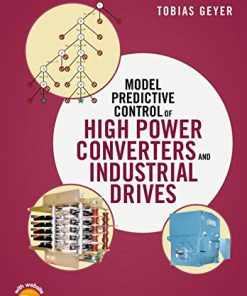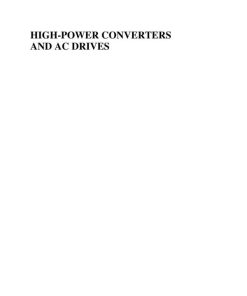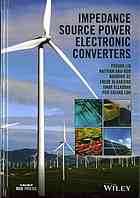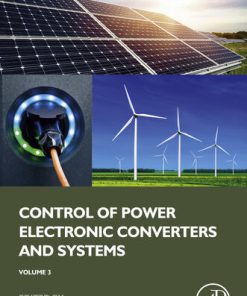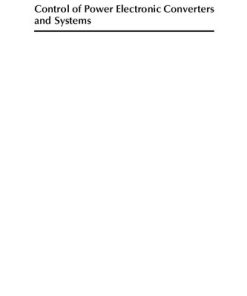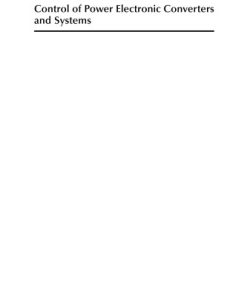Design of Three phase AC Power Electronics Converters IEEE Press 1st Edition by Fei Fred Wang, Zheyu Zhang, Ruirui Chen 1119794234 9781119794233
$50.00 Original price was: $50.00.$25.00Current price is: $25.00.
Design of Three-phase AC Power Electronics Converters (IEEE Press) 1st Edition by Fei “Fred” Wang, Zheyu Zhang, Ruirui Chen – Ebook PDF Instant Download/DeliveryISBN: 1119794234, 9781119794233
Full download Design of Three-phase AC Power Electronics Converters (IEEE Press) 1st Edition after payment.

Product details:
ISBN-10 : 1119794234
ISBN-13 : 9781119794233
Author: Fei “Fred” Wang, Zheyu Zhang, Ruirui Chen
Design of Three-phase AC Power Electronics Converters contains a systematic discussion of the three-phase AC converter design considering various electrical, thermal, and mechanical subsystems and functions. Focusing on establishing converter components and subsystems models needed for the design, the text demonstrates example designs for these subsystems and for the whole three-phase AC converters considering interactions among subsystems. The design methods apply to different applications and topologies.
The text presents the basics of the three-phase AC converter, its design, and the goal and organization of the book, focusing on the characteristics and models important to the converter design for components commonly used in three-phase AC converters. The authors present the design of subsystems, including passive rectifiers, inverters and active rectifiers, electromagnetic interference (EMI) filters, thermal management system, control and auxiliaries, mechanical system, and application considerations, and discuss design optimization, which presents methodology to achieve optimal design results for three-phase AC converters.
Design of Three-phase AC Power Electronics Converters (IEEE Press) 1st Table of contents:
1 Introduction
1.1 Basics of Three‐Phase AC Converters
1.2 Basics of Three‐Phase AC Converter Design
1.3 Goal and Organization of This Book
References
Part I: Components
2 Power Semiconductor Devices
2.1 Introduction
2.2 Static Characteristics
2.3 Switching Characteristics
2.4 Thermal Characteristics
2.5 Other Attributes
2.6 Scalability (Parallel/Series)
2.7 Relevance to Converter Design
2.8 Summary
References
3 Capacitors
3.1 Introduction
3.2 Capacitor Types and Technologies
3.3 Capacitor Selection in a Converter Design
3.4 Capacitor Characteristics and Models
3.5 Capacitor Bank (Parallel/Series)
3.6 Relevance to Converter Design
3.7 Summary
References
4 Magnetics
4.1 Introduction
4.2 Magnetic Core Materials and Construction
4.3 Inductor Design in a Converter
4.4 Inductor Characteristics and Models
4.5 Relevance to Converter Design
4.6 Summary
References
Part II: Subsystems Design
5 Passive Rectifiers
5.1 Introduction
5.2 Passive Rectifier Design Problem Formulation
5.3 Passive Rectifier Models
5.4 Passive Rectifier Design Optimization
5.5 Interface to Other Subsystem Designs
5.6 Summary
References
6 Load‐side Inverters
6.1 Introduction
6.2 Load‐side Inverter Design Problem Formulation
6.3 Load‐side Inverter Models
6.4 Load‐side Inverter Design Optimization
6.5 Load‐side Inverter Interfaces to Other Subsystem Designs
6.6 Summary
References
7 Active Rectifiers and Source‐side Inverters
7.1 Introduction
7.2 Active Rectifier and Source‐side Inverter Design Problem Formulation
7.3 Active Rectifier and Source‐side Inverter Models
7.4 Active Rectifier and Source‐side Inverter Design Optimization
7.5 Impact of Topology
7.6 Active Rectifier and Source‐side Inverter Interfaces to Other Subsystem Designs
7.7 Summary
References
8 EMI Filters
8.1 Introduction
8.2 EMI Filter Design Basics
8.3 EMI Filter Design Problem Formulation
8.4 EMI Filter Models
8.5 EMI Filter Design Optimization and Some Practical Considerations
8.6 EMI Noise and Filter Reduction Techniques
8.7 Interface to Other Subsystem Designs
8.8 Summary
References
9 Thermal Management System
9.1 Introduction
9.2 Cooling Technology Overview
9.3 Thermal Management System Design Problem Formulation
9.4 Thermal Management System Models
9.5 Thermal Management System Design Optimization
9.6 Thermal Management System Interface to Other Subsystems
9.7 Other Cooling Considerations
9.8 Summary
References
10 Control and Auxiliaries
10.1 Introduction
10.2 Control Architecture
10.3 Control Hardware Selection and Design
10.4 Isolation
10.5 Gate Driver
10.6 Sensors and Measurements
10.7 Protection
10.8 Printed Circuit Boards
10.9 Deadtime Setting and Compensation
10.10 Interface to Other Subsystems
10.11 Summary
References
11 Mechanical System
11.1 Introduction
11.2 Mechanical System Design Problem Formulation
11.3 Busbar Design
11.4 Mechanical System Interface to Other Subsystems
11.5 Summary
References
12 Application Considerations
12.1 Introduction
12.2 Motor Drive Applications
12.3 Grid Applications
12.4 Summary
References
Part III: Design Optimization
13 Design Optimization
13.1 Introduction
13.2 Design Optimization Concept and Procedure
13.3 Optimization Algorithms
13.4 Partitioned Optimizers vs. Single Optimizer for Converter Design
13.5 Design Tool Development
13.6 Virtual Prototyping
13.7 Summary
People also search for Design of Three-phase AC Power Electronics Converters (IEEE Press) 1st:
how three phase electricity works
use of three phase power
types of 3 phase converters
what is 3 phase electrical power
three phase ac to dc
Tags: Three phase, Electronics Converters, Fei Fred Wang, Zheyu Zhang, Ruirui Chen
You may also like…
Engineering
Engineering
Impedance source power electronic converters 1st Edition by Yushan Liu 1119037101 9781119037101
Engineering
Control of Power Electronic Converters and Systems: Volume 3 1st Edition Frede Blaabjerg (Editor)
Uncategorized




